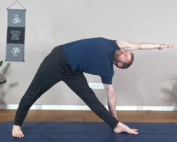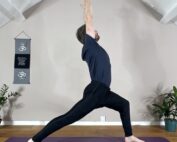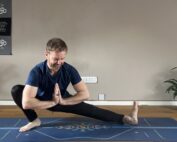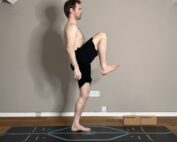
Discover the Steps and Benefits of Utthita Hasta Padangusthasana
Hello! I’m Dav Jones, a yoga teacher and teacher trainer, and I’m excited to guide you through Utthita Hasta Padangusthasana today. In this blog, we’ll explore the details of this balancing posture, its variations, and the many benefits it offers. Whether you’re a beginner working on stability or an advanced yogi refining alignment, there’s something here for you. Ready to enhance balance, strength, and flexibility with this powerful standing pose? Let’s get started!
What is Utthita Hasta Padangusthasana?
Utthita Hasta Padangusthasana, or Extended Hand-to-Big-Toe Pose, is a standing balance pose that requires a combination of neuromuscular coordination, strength, and flexibility. From a kinesiological standpoint, this pose involves activation of key muscle groups across the body while requiring precise joint stabilization and mobility. In this posture, you stand on one leg while extending the opposite leg forward, holding onto the big toe. This pose challenges your proprioception (the body’s awareness of position and movement), strengthens the lower kinetic chain (hips, knees, and ankles), and stretches the hamstrings while emphasizing control, balance, and breath regulation.
The etymology and Sanskrit roots:
- Utthita (Extended)
- Hasta (Hand)
- Padangustha (Big Toe)
- Asana (Pose/Posture),
This asana emphasises control, poise, and a deep connection to the breath.
Utthita Hasta Padangusthasana Basics
| Sanskrit Name | Utthita Hasta Padangusthasana |
|---|---|
| Pronunciation | OOT-hee-tah HAHS-tah PAH-dahn-goos-THAH-sah-nah |
| Meaning | Extended Hand-to-Big-Toe Pose |
| Yoga Level | Intermediate to Advanced |
| Pose Type | Standing, Balancing, Stretching |
Kinesiology Breakdown: Muscles Involved
1. Lower Body: The quadriceps, hamstrings, gluteal muscles, and calf muscles are deeply engaged to stabilize the standing leg and lift the extended leg.
- Quadriceps work to extend the lifted leg.
- Gluteus medius and maximus assist with hip stabilization and balancing the pelvis.
- Hamstrings of the standing leg prevent knee hyperextension and support pelvic stability.
- Calves (gastrocnemius and soleus) assist with maintaining balance by engaging ankle stabilizers.
2. Core Engagement: To keep the spine aligned and resist backward leaning, the rectus abdominis, transverse abdominis, and obliques play a critical role in stabilizing the torso.
3. Upper Body: The deltoids and rotator cuff muscles in the shoulder work to lift and hold the extended arm, while the serratus anterior and latissimus dorsi provide stability to the shoulder girdle during the toe hold.
Benefits of Utthita Hasta Padangusthasana
Physical Benefits:
- Enhances Balance & Stability: Standing on one leg engages proprioceptive feedback, which activates mechanoreceptors in muscles and joints, strengthening the body’s balance response.
- Strengthens the Lower Body: This pose engages muscles that contribute to hip, knee, and ankle stability, particularly enhancing the endurance of postural muscles like the gluteus medius and ankle stabilizers.
- Stretches the Hamstrings: By holding the leg in knee extension, the hamstring muscles are lengthened dynamically, increasing flexibility while also promoting reciprocal inhibition (as the quads contract, the hamstrings eccentrically stretch).
- Opens the Hips: In side variations, the external rotators of the hip, particularly the piriformis and gluteus maximus, engage to allow controlled hip abduction and external rotation.
- Postural awareness: Strengthening postural muscles like the erector spinae, help to keep the spine erect and stable during the posture.
Mental Benefits:
- Boosts Focus & Concentration: Balancing on one leg forces the brain to hone proprioception, requiring greater mental focus and breath synchronization, which cultivates mindfulness.
- Calms the Mind: Balancing postures have a grounding effect that can reduce anxiety and bring practitioners into the present moment, facilitating inner stability.
Step-by-Step Guide to Practicing Utthita Hasta Padangusthasana

How to Get Into the Pose:
- Start in Tadasana (Mountain Pose): Stand tall with feet hip-width apart, arms by your sides.
- Shift Your Weight: Transfer your weight onto your left foot, rooting it firmly into the ground.
- Lift the Right Leg: Finding a focused gaze, slowly start to bend your right knee and bring your thigh up towards your chest.
- Grab the Big Toe: Reach for your right big toe with your right hand, keeping your standing leg strong. A slight bend in the standing knee can help with balance.
- Extend the Leg: Slowly straighten your right leg forward while maintaining a tall posture.
- Hold the Pose: Stay for 5–10 breaths, maintaining balance and a steady gaze.
- Release Slowly: Lower the right foot back down with control, keeping the hamstrings and glutes toned as you transition.
Tip for Beginners:
- If straightening the leg fully is challenging, keep the knee bent or use a yoga strap around the foot.
Modifications and Props
If you need extra support, try these modifications:
- Use a Yoga Strap: If your hamstring flexibility is limited, loop a strap around your foot instead of holding the toe to prevent excessive strain through the outstretched leg, lower back or hip.
- Practice Near a Wall: If balance is a challenge, use a wall for support. Lightly touch the wall with the opposite hand to provide proprioceptive feedback without overly relying on it.
- Keep the Knee Bent: If extending the leg fully isn’t accessible, keeping the knee bent still activates the same muscles and stabilizes the standing leg.
Common Mistakes to Avoid
- Collapsing the Chest: Keep your torso upright by engaging the posterior back muscles and slightly extending the spine.
- Locking the Standing Knee: Hyperextension in the standing leg can destabilize the knee joint. Keep a slight microbend in the knee to ensure muscular engagement rather than passive joint reliance.
Preparatory Poses for Utthita Hasta Padangusthasana
Before attempting this balancing pose, warm up with these preparatory postures:
1. Downward-Facing Dog (Adho Mukha Svanasana)

This pose stretches the hamstrings and calves while engaging the arms and core for stability. It also prepares the hips for flexion.
2. Reclined Big Toe Pose (Parsva Supta Padangusthasana)

- Helps improve hamstring and adductor flexibility in a grounded supine position, reducing strain on the lower back and promoting elasticity of tight muscles.
3. Tree Pose (Vrksasana)

Builds balance, ankle stability, and strength in the standing leg. It also improves focus and grounding, crucial for advanced balancing poses like Utthita Hasta Padangusthasana.
Precautions and Contraindications
While generally safe, keep these precautions in mind:
- Avoid if you have ankle or knee injuries.
- Pregnant practitioners are advised to modify with support.
- If balance is a challenge, hold onto a wall or use a strap.
Variations of Utthita Hasta Padangusthasana
Looking to switch things up? Try these variations:
- Parsva Utthita Hasta Padangusthasana (Side Variation): Open the lifted leg outward to stretch the inner thighs and hips.

- Floating Variation: Instead of holding the big toe, extend the arms forward for added challenge.

Comparisons with Other Standing Poses
Curious about how this pose differs from others? Here’s a quick comparison:
| Pose Name | Similarities | Differences |
|---|---|---|
| Tree Pose (Vrksasana) | Both require balance and stability in the standing leg. | Tree Pose doesn’t require hamstring flexibility or toe grasping. |
| Dancer’s Pose (Natarajasana) | Both are balancing poses that require focus and stability through the standing leg. | Dancer’s Pose requires a different technique. Attention with preparation of backbends and hip opening poses needs to be considered for Dancer’s Pose. |
Final Thoughts
Utthita Hasta Padangusthasana is a fantastic posture that improves balance, flexibility, and concentration. By consistently practicing this pose, you’ll build strength in your legs, deepen your hamstring flexibility, and refine your focus. Whether you’re working on stabilizing your standing leg or extending your lifted leg fully, the journey of this pose is rewarding at every stage.
For further personalized instruction and to enhance your practice, consider joining the Dav Jones Yoga Patreon Channel. Here, you’ll find a comprehensive library of classes suitable for yogis at all levels. If you’re looking for more tailored guidance, the DJY Mentorship programs offer an in-depth, personalized approach to help you delve deeper into the practice of Yoga not only from the physical practice but from the philosophical teachings also.









